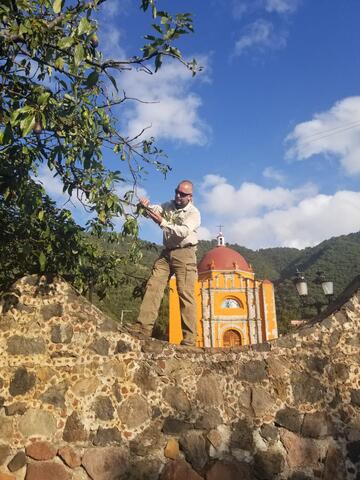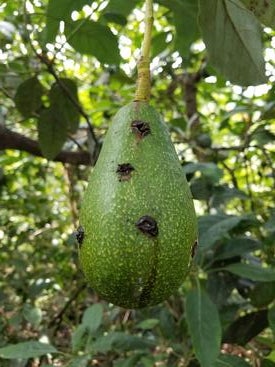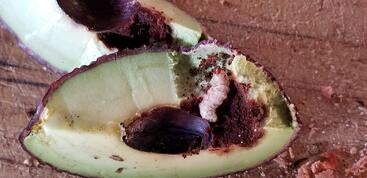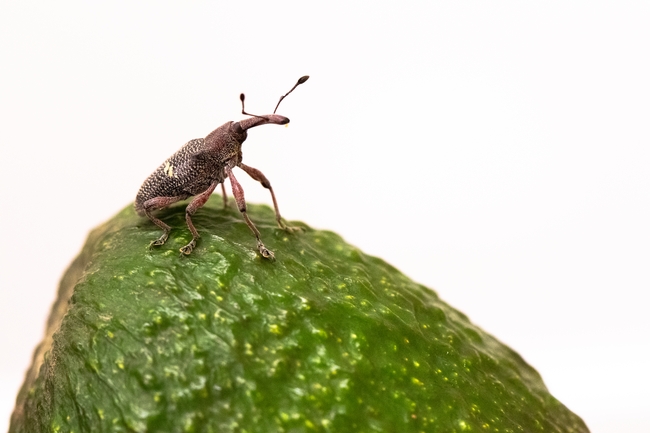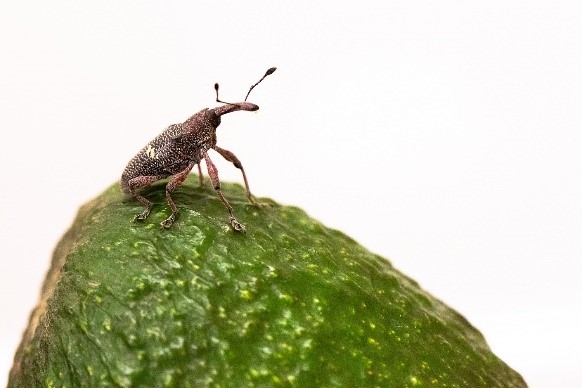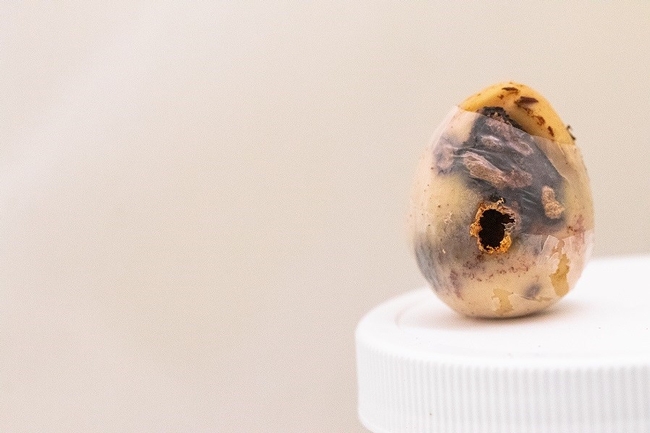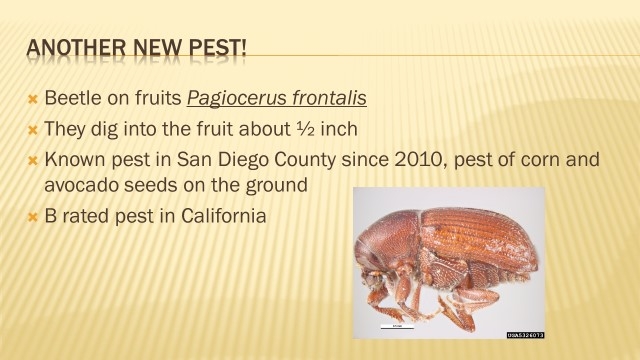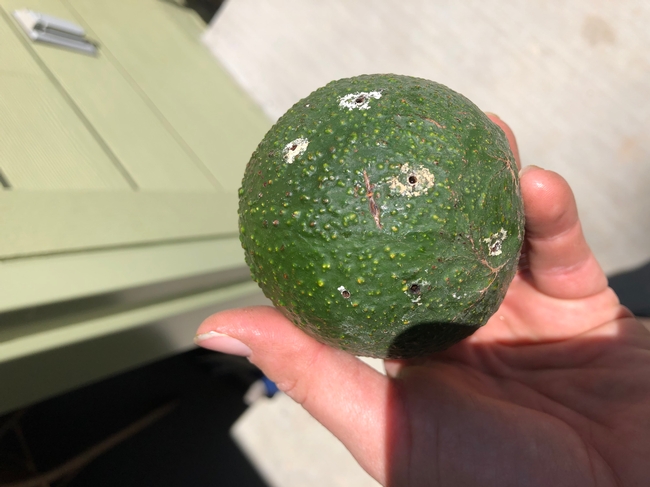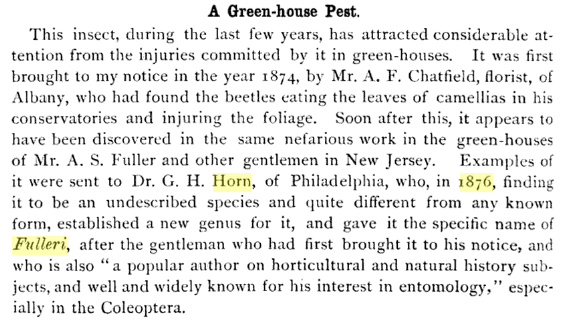
Posts Tagged: weevil
The Smell that Saved the Avocado
UC Riverside scientists are on the hunt for a chemical that disrupts “evil” weevils' mating and could prevent them from destroying California's supply of avocados.
Avocado weevils, small beetles with long snouts, drill through fruit to lay eggs. The weevil grubs or larvae bore into avocado seeds to feed, rendering everyone's favorite toast topping inedible.
“They're extremely hard to control because they spend most of their time deep inside the fruit, where they're very well protected from insecticides and natural enemies,” said UCR entomologist Mark Hoddle.
Not only are the insects reclusive, they are also understudied, making information about them hard to come by. “All books on avocado pest management will tell you these weevils are bad. They're well recognized, serious pests of avocados, but we know practically nothing about them,” Hoddle said.
One strategy for controlling pests is to introduce other insects that feed on them. However, that is unlikely to work in this case. “Natural enemies of these weevils seem to be extremely rare in areas where this pest is native,” Hoddle said.
To combat avocado weevils in Mexico, an area where they are native, and to prevent them from being accidentally introduced into California, Hoddle is working with Jocelyn Millar, a UCR insect pheromone expert. They are leading an effort to find the weevil's pheromone, with the goal of using it to monitor these pests and prevent them from mating in avocado orchards.
Pheromones are chemicals produced and released into the environment by an insect that can be “smelled” by others of its species, and affect their behavior.
“We could flood avocado orchards with so much pheromone that males and females can't find each other, and therefore can't reproduce,” Hoddle said. “This would reduce damage to fruit and enable growers to use less insecticides.”
Alternative control strategies could include mass trapping, using the pheromone as a lure, or an “attract-and-kill” approach, where the pheromone attracts the weevils to small sources of insecticide.
The work to identify, synthesize and test this pheromone in the field is supported by grants from the California Department of Food and Agriculture, as well as the California Avocado Commission.
An initial phase of the project sent Hoddle to a base of operations three hours south of Mexico City, an area with large weevil populations. Using a special permit issued by the USDA, Hoddle brought weevils back to UCR's Insectary and Quarantine facility.
Hoddle and Sean Halloran, a UCR entomology researcher, captured the chemicals that avocado weevils release into the air. Possible pheromone compound formulas were identified from these crude extracts and are now being synthesized in Millar's laboratory.
“Weevil pheromones have complicated structures. When they're made in a lab, they can have left- or right-handed forms,” said Hoddle. Initially, Millar's group made a mixture of both forms to see if the blend would work as an attractant, as it is far cheaper to make the blend than the individual left- or right-handed forms.
Field work in Mexico with the pheromone cocktail by Hoddle, his wife Christina Hoddle, an associate specialist in entomology, and Mexican collaborators did not get a big response from the weevils, suggesting that one of the forms in the blend could be antagonizing the response to the other.
As the next step, the researchers plan to synthesize the individual forms of the chemicals and test the insects' response to each in Mexican avocado orchards.
Because the levels of avocado imports from Mexico are increasing, the risk of an accidental weevil invasion is rising as well. Hoddle is hopeful that the pheromone will be successfully identified and used to lower the risk this pest presents to California's avocado growers.
“We've been fortunate enough to be awarded these grants, so our work can be implemented in Mexico and benefit California at the same time,” Hoddle said. “The tools we develop now can be used to make sure crops from any exporting country are much safer to import into California.”
Avocado Seed Weevil
Proactive Management of the Avocado Seed Weevil, Heilipus lauri
(Coleoptera: Curculionidae)
Mark S. Hoddle, Department of Entomology, University of California Riverside, CA 92521
Avocados are an iconic specialty crop in California that are grown by approximately 4,000 growers who farm around 50,000 bearing acres. The crop is worth ~$350 million per year. The `Hass' variety accounts for >90% of the fruit production in California.
The native range of avocados includes parts of Mexico, Central, and South America and in this area insect biodiversity is high as insects have co-evolved with this plant. In contrast, the biodiversity of the pest arthropod fauna associated with avocados in California is low, consisting primarily of about 4 invasive pest species of insects and mites that feed primarily on leaves, of which one, avocado thrips, Scirtothrips perseae, can cause damage to the skin of immature fruit (Hoddle 2006).
|
Heilipus lauri, the avocado seed weevil |
An Identifiable Invasion Threat – Heilipus spp. Weevils: Currently, California-grown avocados are free from specialist fruit feeding pests such as seed feeding weevils (e.g., Heilipus lauri.) and moths (e.g., Stenoma catenifer). Larvae of these pests bore into fruit to reach the seed. Establishment of these fruit feeding pests in California would cause significant disruption and threaten the long-term economic viability of this industry (Hoddle 2006).
Approximately eight species of Heilipus (there are ~85 species of weevils in this genus) are associated with avocados in the native range. The Heilipus complex attacking avocados fall into two groups:
(1) Fruit boring seed feeders (e.g., H. lauri [Mexico {native}, Colombia {invasive and introduced from Mexico in seeds used for root stocks [Castañeda-Vildózola, et al. 2017]}] H. pittieri [Costa Rica & Nicaragua] and H. trifasciatus[very limited range in Mexico]), and (2) Species that bore into stems and branches (e.g., H. albopictus [Mexico], H. apiatus [native to SE USA], H. cartagraphus [Brazil], H. elegans [Guatemala, Costa Rica, Panama, Colombia, Brazil], and H. rufipes [Brazil]).
Heilipus spp. are considered the most damaging pest complex associated with cultivated avocados (e.g., Hass and Fuerte) in the native range of this crop (Castañeda-Vildózola, et al. 2017; Luna et al. 2017).
Damage caused by Large Avocado Seed Weevil, Heilipus lauri: Adult H. lauri feed on small immature fruit and leaves, and young stems but don't reproduce on these structures (Caicedo et al. 2010). Female seed weevils lay eggs inside holes they drill into fruit using their long beak like snout or rostrum. Hass fruit ~4-5 cm in diameter are preferred for oviposition. Larvae that hatch from eggs deposited into oviposition chambers bore through the fruit pulp to the seed. Upon reaching the seed, larvae burrow
|
A hole in an avocado seed from which an adult H. lauri emerged |
into the seed to feed causing significant internal damage. Mature avocado seed weevil larvae pupate in the seed. Following pupation adults use their mandibles, located on the end of the rostrum, to chew a large circular exit hole to escape from the pupation chamber.
Internal feeding by larvae damages fruit, making it unmarketable, and in some instances heavy damage causes fruit to drop prematurely. In parts of Mexico, H. lauri is a significant pest of Hass avocados. Around 60% of Hass fruit have been reported as being damaged by H. lauri in unmanaged orchards in Morelos, Mexico (Medina 2005). In Colombia, damage levels in heavily managed Hass orchards range ~4-8% (Caicedo et al. 2010).
Control Options: Chemical control is difficult because larvae are protected within fruit (Caicedo et al. 2010). Cultural control (e.g., removal of infested fruit and branches) and trapping using black pyramidal interception traps (i.e., Tedders traps) that serendipitously catch motile weevils are ineffective for suppressing pest populations to non-damaging levels (Vallejo et al. 2014). The natural enemy fauna, especially the identity of parasitoids, attacking weevil eggs, larvae, and pupae is not well documented and natural enemy impacts need quantification (e.g., life table studies) (Caicedo et al. 2010; Castañeda-Vildózola, et al. 2017).
The Threat to California's Avocado Industry: Consequently, Heilipus spp. are listed by USDA-APHIS as avocado pests of high concern for countries that export avocado fruit (i.e., Hass) to the USA from areas where avocados and H. lauri are native (e.g., Mexico) or invasive (e.g., Colombia).
Initiation of a Proactive Mitigation Program for H. lauri: In response to the invasion threat posed by H. lauri to the California avocado industry a proactive mitigation project was initiated in February 2020. This program is supported financially by the California Department of Food and Agriculture's Office of Environmental Farming and Innovation Proactive Integrated Pest Management Solutions grant program.
A major focus of this research program is to identify the aggregation pheromone released by male weevils. If the pheromone can be identified and synthesized it will provide a powerful tool for incursion monitoring in California. Perhaps more importantly, the pheromone can be used in areas with H. lauri activity from which avocados are exported (e.g., parts of Mexico and Colombia) to the USA (especially California) to determine if these areas are free of H. lauri. In addition to detection and monitoring, the pheromone, if highly attractive, may have potency as a mass trapping tool that could be used to control weevils in export areas. This forward-leaning approach would deal with H. lauri at the source and would be an additional step in the pest management chain to further reduce accidental introductions of a serious avocado fruit pest into California.
With respect to the pheromone, this proactive management project has three main objectives: (1) to identify the aggregation pheromone released by male weevils. Progress has been made in Dr. Jocelyn Millar's lab in this respect. Two compounds (one major and one minor) have been identified. (2) Field tests in Mexico in 2021 will be conducted with cooperators with these two putative pheromone compounds to determine their attractiveness. (3) Once the pheromone component(s) is/(are) optimized for weevil attraction they will be deployed in one of seven different commercially available trap types used for catching weevils in agricultural settings. The goal of these field experiments is to identify the most efficacious trap design for use with the weevil pheromone.
So, please stay tuned, there will be a lot new and exciting findings to report on over the next two years!
References
Caicedo, L.R., E.V. Devia, T. Bacca, and A. Carabali. 2010. Daños ocasionados por el perforador del aguacate Heilipus lauri Boheman (Coleoptera: Curculionidae) en Tolima (Colombia). Revista Corpoica - Ciencia y Tecnología Agropecuaria 11: 129-136.
Castañeda-Vildózola, Á. et al. 2007. Genitalia de tres especies de Heilipus Germar (Coleoptera: Curculionidae) que dañan frutos de aguacate (Persea americana Mill) en México y Costa Rica. Neotropical Entomology 36: 914-918.
Castañeda-Vildózola, Á. et al. 2017. Sympatry of two species of Heilipus Germar, 1824 (Coleoptera: Curculionidae) infesting avocado (Persea americana Mill.) in Central Mexico. The Coleopterist's Bulletin 71: 361-363.
Hoddle, M.S. 2006. Lurkers on the threshold: Potential new fruit pests for California avocados. California Avocado Society Yearbook 89: 69-92.
Luna, A., V. López-Martínez, N. Bélgica Pérez-De la O, D. Jiménez-García, R.W. Jones, Á. Castañeda-Vildozola, and C. Ruiz-Montiel. 2017. Actual and potential distribution of five regulated avocado pests across Mexico, using the maximum entropy algorithm. Fla. Entomol. 100; 92-100.
Medina Q.F. 2005. Incidencia del barrenador grande del hueso del aguacate Heilipus lauri Boheman (Coleoptera: Curculionidae) en Tepoztlan, Morelos, Cuernavaca, Facultad de Ciencias Agropecuarias, Universidad Autónoma de Morelos. MS tesis, 39 pp.
Vallejo A.M.C., E. Arévalo, L.F. Torres, M.P. González, M.F.D. Niño. 2014. Especies Cuarentenarias del aguacate Hass en el Oriente de Antioquia y el Norte del Tolima en Colombia. Instituto Colombiano Agropecuario, ICA y Colciencias, 40pp.
Read more at: http://ceventura.ucanr.edu/Com_Ag/Subtropical/
Avocado Seed Weevil
There have been recent reports of a beetle infesting downed avocado fruit in Ventura County. This scolytid weevil was first reported in San Diego in 2010. Gary Bender found it in a high density planting where fruit was lying on the ground.
The reports in Ventura have been of fruit that has found on the ground. It's a “B” rated pest that previously had only been reported from the Andes through Central America and Mexico into North Carolina. The main threat is to stored corn. The weevil is about the size of a sand grain. The photo below is by Alana King.
The beetle burrows into the fruit where the larvae tunnel the flesh.
Image - Aimee Smith
Image: Alana King
The avocado reports here have involved some superficial tunneling into the fruit flesh, although its various names include seed weevil. This is not the seed weevils Helipus or Conotrachelus which cause so much damage in Mexico
This insect probably is not a major threat to avocado, but just demonstrates again how easily pest infestations occur.
Get the Latest on Fuller Rose Beetle/Weevil
UC Ag Expert talks about Fuller rose beetle
Date: January 23, 2019
Time: 3:00 PM - 4:00 PM
Contact: Petr Kosina pkosina@ucanr.edu
Sponsor: UC Ag Experts Talk
Location: Webinar
Event Details
Register in advance for webinar at
https://ucanr.zoom.us/webinar/register/WN_RIYGPBgkTo6o_hPooWlfmg
Participants of this webinar will receive 1 DPR hour of 'Other' CE units and 1 CCA hour of IPM CE units
Note: This webinar has no fee.
Dr. Beth Grafton-Cardwell, citrus IPM specialist and research entomologist, will discuss the lifecycle, damage to citrus, monitoring, methods of control and export issues associated with Fuller rose beetle. Participants can use the chat function of the webinar to ask questions.
Event Reminder
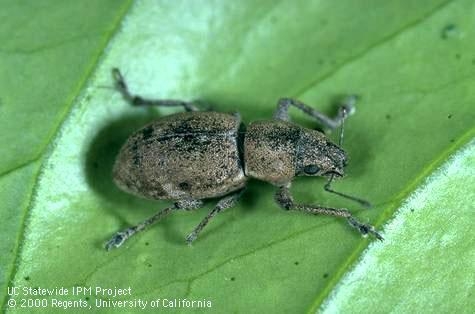
fuller rose beetle
Ag Expert on Fuller Rose Beetle and CEUs
UC Ag Expert talks about
Fuller rose
beetle (weevil)
Date: January 23, 2019
Time: 3:00 PM - 4:00 PM
Contact: Petr Kosina pkosina@ucanr.edu
Sponsor: UC Ag Experts Talk
Location: Webinar
Event Details
Register in advance for webinar at:
https://ucanr.zoom.us/webinar/register/WN_RIYGPBgkTo6o_hPooWlfmg
Participants of this webinar will receive 1 hour of 'Other' CE units
Note: This webinar has no fee.
Dr. Beth Grafton-Cardwell, citrus IPM specialist and research entomologist, will discuss the lifecycle, damage to citrus, monitoring, methods of control and export issues associated with Fuller rose beetle. Participants can use the chat function of the webinar to ask questions.
http://ipm.ucanr.edu/PMG/r107300311.html
http://entnemdept.ufl.edu/creatures/orn/beetles/fuller_rose_beetle.htm
Event Reminder

fuller rose beetle

